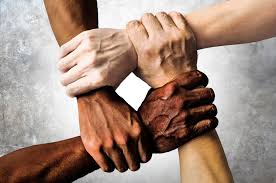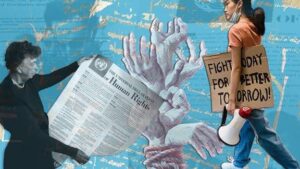
Laknara Jayalath
Echoes of Dignity: Why Human Rights Law Still Lights the Way in a Shadowed World

A young woman, Aisha, huddles in a cramped tent on the outskirts of a war-torn city in the dim light of a dying lantern. Despair and dust are thick in the air, and the distant rumble of artillery offers a macabre lullaby. Aisha, a teacher by training, fled her home when militias razed her village, killing and crushing dreams in the name of some shattered ideology. But in her ripped notebook, she clutches a tattered copy of the Universal Declaration of Human Rights, a talisman against the chaos. “Article 5: No one shall be subjected to torture,” she whispers to herself, as if reciting an old incantation. This is no fairy tale. It is the plain truth of human rights law in action, a legal symphony that still plays on even when the world seems tuned to discord.
Human rights law, that intricate weave of international treaties, national constitutions, and moral commitments, is not mere legalese buried in dusty tomes. It is the heartbeat of our shared humanity, coursing through the darkest corridors of history to remind us that every soul deserves dignity. Born in the wake of World War II, when the horrors of the Holocaust and atomic conflict exposed the fragility of civilization, this system has evolved into a global watchdog. Its catalyst was the Universal Declaration of Human Rights (UDHR), which the United Nations ratified in 1948. Treaties like the International Covenant on Civil and Political Rights (ICCPR) and the Convention on the Elimination of All Forms of Discrimination Against Women (CEDAW) added fuel to the flames. But in a time of rising authoritarianism, digital mass surveillance, and climate disasters, why does it even count? Why bother when algorithms determine our fate and borders harden like scar tissue? For, as we will chart through stories, metaphors, and unyielding facts, human rights law is no dinosaur. It is the guiding light that takes us to a better morning. This creative journey weaves personal narratives with analytical insights, showing its profound relevance in our polarized world.
Consider human rights law a great oak tree, its roots sinking deep into the soil of common suffering, its arms extensive to offer shelter to the vulnerable. At its base is the protection of the individual, a vital shield against the tempests of oppression. In Aisha’s world, where war devours the innocent, laws like the Geneva Conventions and the ICCPR are the guardians. They assert that even in war, there are certain boundaries that cannot be crossed. There are no summary killings, no forced disappearances, no dehumanizing treatment. For refugees like Aisha, the 1951 Refugee Convention offers the embrace of asylum, ensuring the right to seek safety without repatriation to harm. This is not abstract. It is the difference between existence and oblivion.
Consider the case of Malala Yousafzai, the Pakistani activist whose voice rang out like a clarion call against the Taliban’s repression of education for girls. Shot in the head at the age of 15 for having the temerity to learn, Malala survived not just through medical miracles but through the invocation of human rights principles. The UN spotlight on her case, brought to the fore by Article 26 of the UDHR (right to education), compelled the world powers to condemn the violence and fund initiatives for women empowerment. Malala’s Nobel in 2014 was not merely an award. It was human rights law assuming shape as global solidarity, inspiring millions of girls to seize their futures. Were it not for this legal protection, her story might have been stifled, a footnote in the textbook of oppression.
But it is not only on distant battlefields that this armor glows. Closer to home, on city streets today, human rights law battles more subtle foes: discrimination and inequality. Think of the landmark case of Loving v. Virginia in 1967, when the U.S. Supreme Court struck down bans on interracial marriage, citing equal protection principles fueled by international human rights norms. Richard and Mildred Loving’s quiet resistance, founded on love that knew no racial bounds, spread outward, dismantling the walls that had once closed off hearts and lives. Now, as Black Lives Matter and other movements remind us of these battles, laws banning racial profiling, backed by the International Convention on the Elimination of All Forms of Racial Discrimination (ICERD), ensure no one’s humanity is on the negotiating table. In Brazil, indigenous peoples invoke the UN Declaration on the Rights of Indigenous Peoples to protect Amazon rainforests from deforestation, transforming legal rights into ecological lifelines.
This protection of essence carries over to the virtual realm, where surveillance shadows are long. When facial recognition technology is able to pick out dissenters at a distance, the right to privacy (Article 12 of the UDHR) becomes a digital fortress. Activists in Hong Kong, in their protests against Beijing’s incursions, have tapped human rights law to resist the National Security Law on the basis that it erodes freedom of expression and assembly. The European Court of Human Rights, through cases like Big Brother Watch v. the UK, has ruled against mass surveillance, affirming that privacy is not a luxury but a right woven into the fabric of liberty. As AI evolves, frameworks like the UN’s Global Digital Compact aim to embed human rights in technology, preventing a future where data becomes the new chains of bondage. Without such laws, we would descend into a universe of panopticon, where Big Brother’s gaze chokes the human spirit, transforming innovation into invasion.
While protection is the shield, accountability is the sword: piercing, uncompromising, and tempered to slash through the veil of impunity. Human rights law transforms governments from inviolate monarchs to accountable stewards, bound by treaties they cannot merely discard. Picture a courtroom not of wood-paneled drama but of global attention: the International Criminal Court (ICC) in The Hague, where dictators and warlords are held accountable for atrocities. This is not vengeance. It is the silent revolution of justice, holding the abusers of power accountable for their actions.
The trial of Charles Taylor, former president of Liberia, is a case in point. Convicted in 2012 for facilitating Sierra Leone’s blood diamond trade atrocities, Taylor’s fall was a tribute to the Rome Statute’s long arm. Human rights law did not only punish. It deterred, communicating that the throne of power is founded on sand if it is tainted with innocent blood. In the African continent, where colonial legacies hold sway, the African Charter on Human and Peoples’ Rights has allowed regional courts to hold leaders accountable, from Zimbabwe’s election manipulations to Sudan’s genocide in Darfur. The African Court on Human and Peoples’ Rights, though under-funded, has issued judgments that force governments to reform, including ordering compensation for mass evictions in Kenya.
However, accountability is not the preserve of international fora. It permeates national terrain. In India, the National Human Rights Commission has investigated custodial death and caste violence, invoking the fundamental rights in the Constitution drawn from the UDHR. During the 2020 farmers’ protests, human rights lawyers cited the right to peaceful assembly, forcing conversations that stalled further bloodshed. This mechanism builds trust: when citizens see justice served, they invest in society rather than retreating into cynicism. In Latin America, truth commissions in post-dictatorship Argentina and Chile uncovered graves and healed wounds, using human rights law to transition from terror to truth.
Economically, accountability empowers equity. The UN Guiding Principles on Business and Human Rights prod companies like Nestlé or ExxonMobil to respect labor rights in supply chains. The 2013 Rana Plaza collapse in Bangladesh, killing over 1,100 garment workers, ignited a firestorm. Human rights campaigners, citing the right to safe working conditions under International Labour Organization conventions, battled for the Accord on Fire and Building Safety, a binding agreement that has inspected thousands of factories, saved lives, and improved standards. This ripple effect shows how accountability of the powerful gives power to the powerless, turning the pursuit of profit into a partner of progress.
The sorcery of human rights law lies in its universality, a tapestry in which culture, religion, and geography are threads woven together without unraveling. In a divided world, it is a common language, bridging gulf politics and prejudice widen. The preamble to the UDHR announces rights as “a common standard of achievement for all peoples,” understanding that customs vary but inherent dignities remain. It is not cultural imperialism. It is sympathetic justice, allowing for such adaptations as Islamic states adopting Sharia as well as UDHR principles or indigenous peoples asserting collective rights alongside individual rights.
In the face of climate change, human rights law manifests as an environmental morality. The Paris Agreement tacitly recognizes rights when it speaks of the displacement of island nations like Tuvalu by encroaching seas, invoking the right to life and a healthy environment (included in over 150 national constitutions). Pacific activists, through the UN human rights machinery, hold polluters accountable on the basis that emissions violate future generations’ rights. This global tapestry prevents “rights relativism,” where powerful states justify atrocities under sovereignty’s cloak, such as China’s Uyghur policy critique or Russia’s Ukraine invasion critique.
It also sparks social progress, rendering rights achievable. The Convention on the Rights of the Child, ratified by nearly all states, has reduced child labor and boosted school attendance worldwide. In sub-Saharan Africa, where HIV/AIDS had orphaned millions, rights-based initiatives secured access to antiretrovirals, halving pediatric infections. Economically, the right to health is linked to GDP growth. World Bank scholars link strong human rights protection to innovation and stability, e.g., Nordic models wherein gender equality (via CEDAW) galvanizes inclusive economies.
Finally, human rights law is the poet’s pen, inscribing stories of resistance that stir the heart. It is the force behind #MeToo’s global reckoning, when survivors employed anti-discrimination laws to topple titans like Harvey Weinstein. In Tahrir Square, during the Arab Spring, protesters waved UDHR flags, demanding freedoms that toppled Mubarak’s regime. Even in quiet victories, like Taiwan’s 2019 legalization of same-sex marriage, the first in Asia, human rights law was the map, proclaiming love’s universality.
And still the challenges persist: backsliding on media freedom in Hungary, technology giants evading accountability, or pandemics exposing inequalities. Yet, as Eleanor Roosevelt dreamed, rights begin “in small places, close to home, so close and so small that they cannot be seen on any map of the world.” Aisha’s whisper in her tent, a lawyer’s argument in a court of law, a child’s first day of school, these are human rights law’s living poems.
In this shadow world, human rights law matters as it rekindles our light. It protects the vulnerable, binds the powerful, brings together the divided, and ignites the aspirational. Without it, we would grope in darkness. With it, we walk on into the dawn of dignity. As Aisha reads aloud to her makeshift classroom under the stars, quoting Article 1, “All human beings are born free and equal,” we remember: this law is not just words on paper. It is the echo of our shared humanity, reverberating forever.
